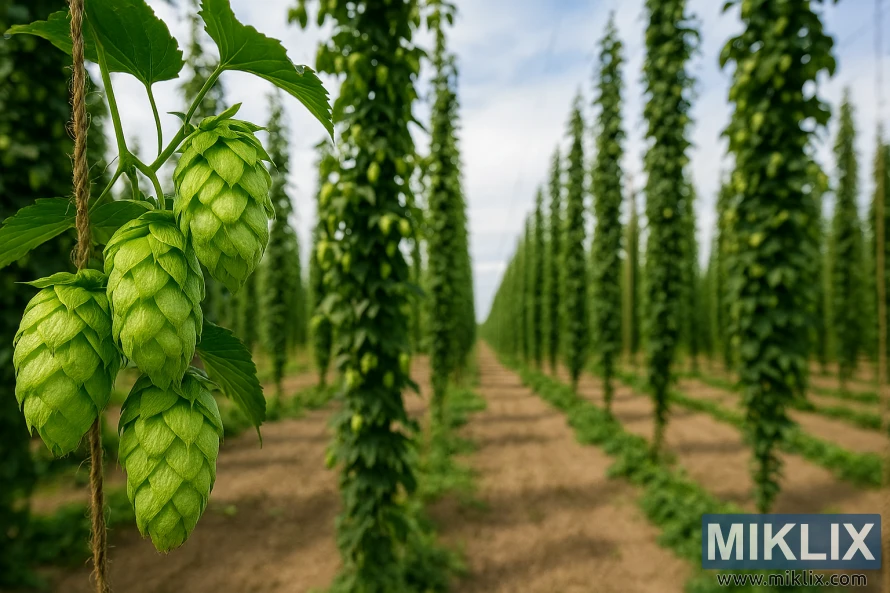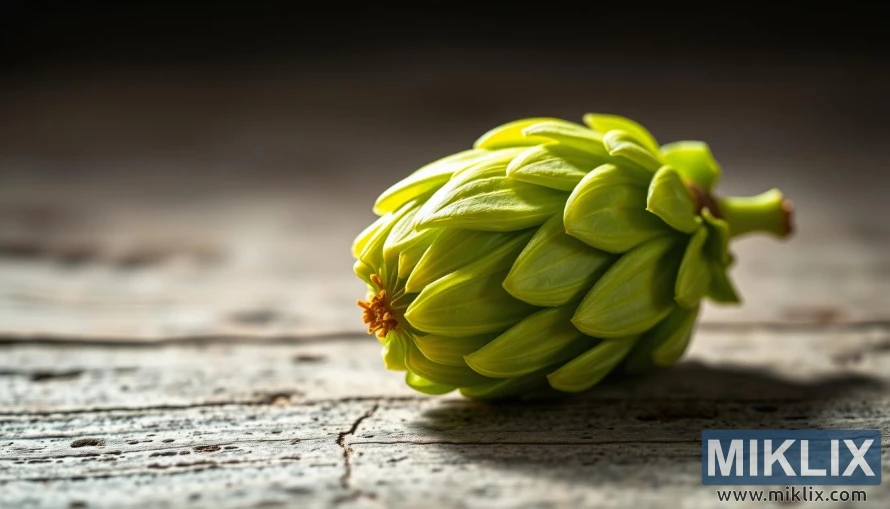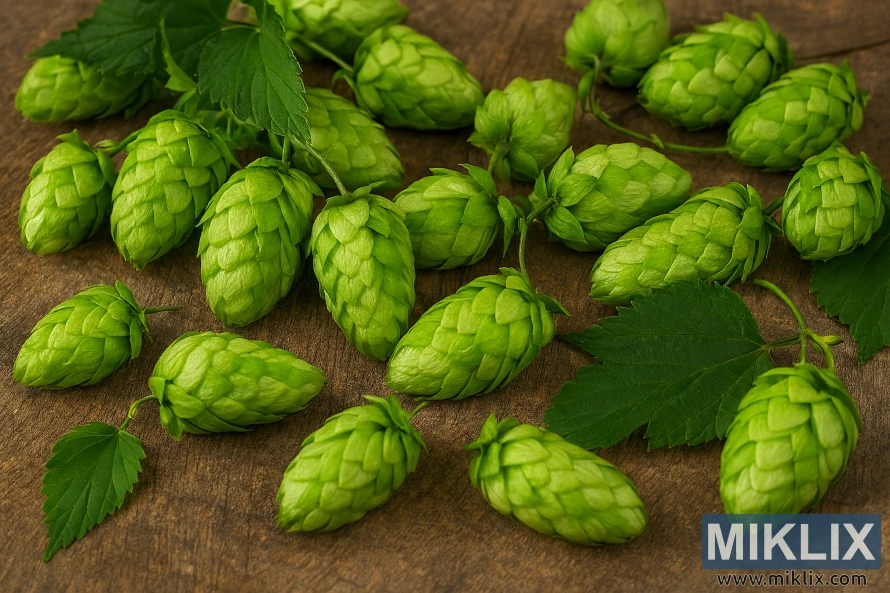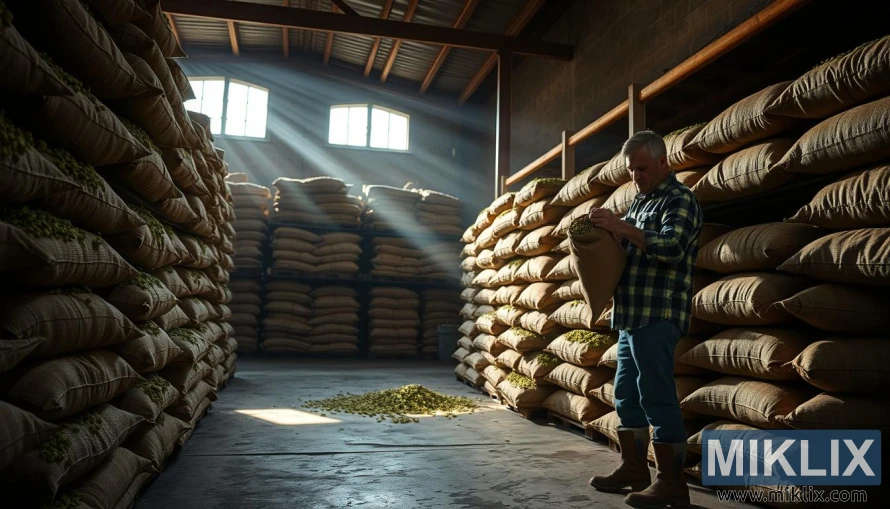Hops in Beer Brewing: Amarillo
Published: July 21, 2025 at 2:58:46 PM UTC
Last updated: November 25, 2025 at 2:19:14 PM UTC
Beer brewing is an art that demands precision and the right ingredients. The selection of hop varieties is key to crafting unique beers. Amarillo hops, developed by Virgil Gamache Farms in Washington State, stand out for their distinct flavor and high alpha acid content. These traits make them perfect for brewers aiming to add citrus, floral, and tropical fruit notes to their beers. By grasping the history, characteristics, and brewing applications of Amarillo hops, brewers can enhance their skills. This leads to the creation of complex, flavorful beers.

Key Takeaways
- Amarillo hops offer a unique flavor profile with notes of citrus, floral, and tropical fruit.
- High alpha acid content makes them suitable for various beer styles.
- Understanding the characteristics of Amarillo hops is essential for effective brewing.
- Amarillo hops can be used to create complex, flavorful beers.
- Brewing with Amarillo hops requires precision and the right techniques.
What Are Amarillo Hops?
The tale of Amarillo hops starts with a chance find in 1990. This event marked the beginning of their rise to fame in the craft brewing world. They were found as a mutation in a hop field in Washington State. Virgil Gamache Farms then cultivated and patented them.
Amarillo hops are now celebrated for their unique traits. These have made them a key player in the craft beer scene. Their distinct aroma and flavor have drawn brewers from around the globe. This has made them a go-to choice for many beer styles.
The history and origin of Amarillo hops add to their allure. Being a newer hop variety, they bring a fresh approach to brewing. This allows brewers to craft innovative, complex beers that meet changing consumer preferences.
For brewers aiming to use Amarillo hops, understanding them is key. We will dive into their characteristics and brewing techniques in the following sections. This will offer a detailed guide for those in the craft brewing field.
Essential Characteristics of Amarillo Hops
Amarillo hops stand out in the brewing world with their high alpha acid content and unique flavor. They are prized for their versatility, adding distinct qualities to beer.
Their alpha acid content, ranging from 8-11%, is a key feature. This makes them ideal for bittering, adding a strong bitterness to various beers.
Amarillo hops are also celebrated for their flavor. They bring citrus, floral, and tropical fruit notes to beer. This enhances both the aroma and flavor, making them a favorite for brewers aiming for refreshing, fruity beers.
- High alpha acid content (8-11%) for robust bitterness
- Distinct flavor profile with notes of citrus, floral, and tropical fruit
- Versatile and suitable for various beer styles
The blend of high alpha acid content and unique flavor makes Amarillo hops essential in brewing. They help craft beers that are both complex and refreshing.
Aroma and Flavor Profile
Amarillo hops are celebrated for their complex and distinct aroma and flavor profile. They include notes of citrus, floral, and tropical fruit.
These hops are a popular choice among brewers due to their unique characteristics. The aroma is intense and aromatic, with a pronounced citrus character. This adds brightness to beers.
The flavor profile of Amarillo hops is equally complex. It offers notes of orange, lemon, and other citrus fruits. It also has subtle floral hints.
This versatility makes Amarillo hops suitable for a variety of beer styles. They are often used in pale ales to IPAs. They add depth and complexity to the beer's overall character.
Technical Specifications
The technical specifications of Amarillo hops, including alpha acid content and oil composition, play a significant role in beer brewing.
Amarillo hops are known for their high alpha acid content, which typically ranges from 8-11%. This characteristic makes them highly useful for bittering applications in brewing.

The oil composition of Amarillo hops is also noteworthy. It features a blend of myrcene, humulene, and caryophyllene. These compounds contribute to the complex aroma and flavor profiles that Amarillo hops impart to beer.
- Alpha acid content: 8-11%
- Major oil components: myrcene, humulene, caryophyllene
Understanding these technical specifications is essential for brewers. It allows them to harness the full flavor and aroma of Amarillo hops in their recipes.
Best Beer Styles for Amarillo Hops
Amarillo hops are a favorite among brewers for their unique flavor and aroma characteristics. They are suitable for a variety of beer styles.
Amarillo hops are well-suited for beer styles that highlight their citrus and floral notes. Some of the most popular beer styles that use Amarillo hops include:
- Pale Ales: Amarillo hops add a bright, citrusy flavor to pale ales, making them a popular choice among brewers.
- IPAs: The citrus and pine notes of Amarillo hops complement the hoppy flavor of IPAs, creating a balanced and complex taste experience.
- Other styles: Amarillo hops can also be used in other beer styles, such as wheat beers and saisons, to add a unique twist to traditional recipes.
When brewing with Amarillo hops, it's essential to consider their alpha acid content and flavor profile. This helps achieve the desired balance in your beer.
Here are some key considerations for brewers looking to use Amarillo hops in their recipes:
- Use Amarillo hops in combination with other hop varieties to create a complex flavor profile.
- Experiment with different hop addition times to achieve the desired balance of flavor and aroma.
- Consider the alpha acid content of Amarillo hops when calculating bitterness levels.
Brewing Applications and Techniques
Amarillo hops are a versatile ingredient in beer brewing, suitable for a range of applications. They can be used for bittering, flavor, and aroma additions, making them a popular choice among brewers.
When using Amarillo hops for bittering, it's essential to consider the alpha acid content and the boil time to achieve the desired level of bitterness. For flavor and aroma additions, the timing of hop additions during the brewing process can significantly impact the final character of the beer.
Some brewers prefer to use Amarillo hops in late boil additions or dry-hopping to maximize their flavor and aroma. Others may use them in combination with other hop varieties to create complex and balanced flavor profiles.
- Use Amarillo hops for bittering additions to contribute a unique bitterness profile.
- Employ late boil additions or dry-hopping to enhance the flavor and aroma of the beer.
- Experiment with blending Amarillo hops with other hop varieties to create complex flavor profiles.
By understanding the brewing applications and techniques for using Amarillo hops, brewers can unlock the full versatility of this hop variety. This allows them to create high-quality beers with distinct characteristics.

Hop Schedule Recommendations
A well-structured hop schedule is key to highlighting Amarillo hops' unique traits. By planning hop additions carefully, brewers can enhance the beer's flavor and aroma. This approach ensures the hops' impact is maximized.
When crafting a hop schedule, consider the stages of hop addition: bittering, flavor, and aroma. Amarillo hops are best used for bittering at the boil's start. Flavor and aroma additions come later.
- Use Amarillo hops for bittering additions at 60-90 minutes into the boil.
- Make flavor additions at 15-30 minutes remaining in the boil.
- Use Amarillo hops for aroma additions in the last 5-10 minutes of the boil or during dry-hopping.
By adhering to these guidelines, brewers can create a balanced and complex beer. This showcases Amarillo hops' unique characteristics.
Experimenting with hop schedules and techniques is vital. It helps brewers tailor their approach to their beer style and desired flavor profile.
Storage and Handling
To preserve the unique characteristics of Amarillo hops, brewers must store and handle them correctly. Proper storage and handling are key to maintaining the flavor and aroma of these hops.
Amarillo hops should be stored in a cool, dry place to preserve their flavor and aroma characteristics. This means keeping them away from direct sunlight, moisture, and heat sources.
When handling Amarillo hops, it's essential to minimize exposure to air, as oxygen can cause the hops to degrade over time. Brewers should also avoid touching the hops excessively, as the oils from their skin can contaminate the hops.
- Store Amarillo hops in airtight containers to prevent exposure to air.
- Keep the storage area cool, with temperatures ideally below 40°F (4°C).
- Minimize handling to prevent damage and contamination.
- Use the hops within a year of storage for optimal flavor and aroma.
By following these storage and handling practices, brewers can ensure that their Amarillo hops retain their unique flavor and aroma characteristics. This leads to better-quality beers.

Commercial Growing Regions
Regions with suitable climates are ideal for growing Amarillo hops commercially. The United States is home to several key areas where this variety is cultivated.
Washington State is a primary region for Amarillo hop cultivation. The Yakima Valley and Columbia Basin are notable areas within the state known for their hop farms. These regions offer the ideal climate and soil conditions necessary for growing high-quality Amarillo hops.
Other areas in the United States also contribute to the commercial cultivation of Amarillo hops. Oregon and Idaho are among the states that have hop farms where Amarillo is grown. The diverse geography and climate across these regions allow for a range of growing conditions. This can affect the flavor and aroma profiles of the hops.
- The Pacific Northwest is well-suited for hop cultivation due to its climate.
- Hop farms in these regions often employ advanced agricultural practices.
- The quality of Amarillo hops from these areas is highly regarded in the brewing industry.
The commercial growing regions for Amarillo hops play a critical role in the availability and quality of this hop variety for breweries. Understanding these regions can help brewers make informed decisions about sourcing Amarillo hops.
Substitutes for Amarillo Hops
Brewers seeking alternatives to Amarillo hops have several options. Amarillo hops are celebrated for their distinct flavor and aroma. Other hop varieties can serve as substitutes in emergency situations.
Cascade, Centennial, and Simcoe hops are common substitutes for Amarillo. They share similarities with Amarillo in citrus and floral notes. This makes them suitable for many beer recipes.
Cascade hops are known for their floral and citrus flavors. They complement a wide range of beer styles. Centennial hops offer a balanced flavor and aroma with a hint of bitterness. Simcoe hops, with their intense pine and earthy notes, are ideal for robust beer styles.
When substituting Amarillo hops, brewers must consider the replacement hop's characteristics. Adjusting the hop schedule or the amount of hops used may be necessary. This ensures the desired flavor and aroma profile is achieved.
- Cascade: Floral and citrus flavors, suitable for pale ales and IPAs.
- Centennial: Balanced flavor and aroma, slightly bitter, versatile in various beer styles.
- Simcoe: Pine and earthy character, ideal for more robust beer styles like double IPAs.
Understanding the characteristics of these substitute hop varieties is key. This knowledge allows brewers to make informed decisions when Amarillo hops are unavailable. It ensures their beer recipes remain consistent and flavorful.
Common Brewing Mistakes to Avoid
Amarillo hops can transform a beer, but only if brewers steer clear of common pitfalls. Known for their distinct flavor and aroma, these hops are a staple in craft brewing. Yet, their unique profile demands careful handling.
One frequent error is over-hopping with Amarillo hops. Their potent flavor and aroma can lead brewers to overestimate the amount needed. Too much can make the beer taste bitter or overpowering.
- Use Amarillo hops judiciously, as their flavor and aroma can quickly become overpowering.
- Be mindful of the timing of hop additions to maximize the unique qualities of Amarillo hops.
- Store Amarillo hops properly to preserve their flavor and aroma.
- Experiment with different hop varieties alongside Amarillo hops to create complex and balanced flavors.
Understanding Amarillo hops' technical specs is key. This knowledge helps brewers use these hops effectively.
Some important technical details include:
- Alpha acid content: Amarillo hops typically have an alpha acid content ranging from 8-11%.
- Beta acid content: They also contain beta acids, which contribute to their bittering.
- Storage: Proper storage in a cool, dry place is essential to maintain quality.
By avoiding common mistakes and following these tips, brewers can fully exploit Amarillo hops. This way, they can craft beers that highlight these hops' unique qualities.
Recipe Examples and Success Tips
Brewing with Amarillo hops offers a range of recipe examples and techniques. Known for their citrus and floral notes, they're perfect for pale ales, IPAs, and more. This versatility makes them a favorite among brewers.
Here are a few recipe examples to try:
- Pale Ale: Use Amarillo hops for bittering, flavor, and aroma to create a balanced and refreshing pale ale.
- IPA: Add Amarillo hops late in the boil to emphasize their citrus and floral characteristics in an IPA.
- Wheat Beer: Use Amarillo hops to add a subtle citrus note to a wheat beer.
To succeed with Amarillo hops, follow these tips. First, consider the hop's alpha acid content and adjust your hop schedule. Second, think about the beer's style and flavor profile when using Amarillo hops. Lastly, don't hesitate to experiment. Amarillo hops are incredibly versatile, allowing for creative brewing.
Conclusion
Brewing with Amarillo hops presents a chance to craft beers with complex and rich flavors. These hops are versatile, suitable for a range of beers, from pale ales to IPAs. Their unique qualities make them a standout choice for brewers.
When using Amarillo hops, it's important to consider their essential characteristics, aroma, and flavor. Understanding these aspects helps brewers fine-tune their brewing techniques. This ensures that the beers they create fully showcase the hops' unique qualities.
In summary, Amarillo hops are a valuable asset for brewers. By adhering to the guidelines discussed, brewers can harness the full flavor of these hops. This leads to the creation of exceptional beers that highlight the hops' distinct characteristics.

Further Reading
If you enjoyed this post, you may also like these suggestions:
